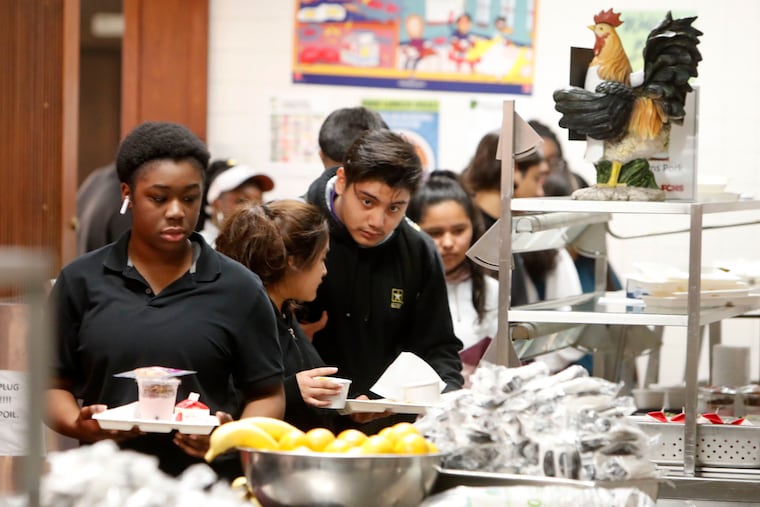Aramark exec: National School Lunch Program needs extension to feed hungry kids during pandemic | Opinion
That is the best way to ensure our schools can continue providing meals to our neediest students, and that no child goes hungry.

Amid all the debate around the coronavirus, there has been at least one area that has received fairly widespread and bipartisan support: the need to ensure our nation’s neediest children do not go hungry as a result of the ongoing pandemic. Unfortunately, due to the U.S. Department of Agriculture (USDA) and Congress not extending needed regulatory relief to schools, we now face the possibility that tens of thousands of American children could start going without meals in a matter of weeks.
Since its establishment in 1946, the federal National School Lunch Program (NSLP) has been reimbursing schools for providing needy children with free or reduced-price meals. In recent years, the program has supported nearly 100,000 K-12 schools and close to 30 million children. For many of these children, the meals they are provided at school may be the only healthy and regular meals they receive.
Under the NSLP, there are strict regulations around dietary guidelines and where and how food is provided. Schools are required to carefully track distribution to ensure only eligible children receive meals. As schools began closing in mid-March due to the pandemic, the USDA, with the support of Congress, moved quickly to issue waivers to these regulations to allow schools to provide meals through the agency’s more flexible summer programs.
» READ MORE: Number of households with hungry children nearing 14 million, study finds
These waivers have been critical to ensuring that schools can continue to get food to our most vulnerable kids. For example, under the summer program rules, schools have been able to provide no-contact, curbside food distribution to any child under the age of 18, without requiring verification that a child attends the school where the food is being distributed. This has enabled parents with limited means of transportation to visit the closest food distribution site to their home and pick up meals for multiple children, instead of visiting sites across town, depending on where their children are enrolled.
Despite the resounding success of these waivers, not all of them have been extended for the 2020-21 school year. If that extension doesn’t come through soon, we may see many children go hungry this fall. At a time when we still face record unemployment, schools are anticipating a significant increase in the number of children in need of this food assistance.
While some schools will resume in-person learning, where normal food distribution could theoretically take place, many will not. Other schools will start out in person, but change their status at some point in the fall in response to outbreaks or exposures. Among the more than 400 K-12 school districts across the country where food service is provided by Aramark, where I work, 70% are planning to conduct fully — or partially — remote learning for at least the first six to eight weeks of the fall semester.
Returning to the strict regulations of the NSLP right now is creating a logistical nightmare for schools, parents, and children. For schools conducting remote learning and needing to continue with curbside food distribution, school staff will need to maintain a roster of eligible children, determine whether each child is eligible for free, reduced-price, or full-price meals, and have the curbside capability to take payments from children when required. In addition to the logistical complexity, these transactions significantly increase the risk of COVID exposure for everyone involved.
Even for schools that fully reopen, NSLP regulations will make it difficult for meal providers to offer staggered breakfasts and lunches to help maintain social distancing among students. So the rules will actually discourage full reopening and possibly even increase the chance of a virus outbreak that would force the school to shut its doors once again.
» READ MORE: Hunger expected to explode here, throughout America, because of COVID-19
We are already starting to see the impact of a too-soon return to NSLP regulations. In a school district near Austin, Texas, which Aramark serves, 54% of the population qualifies for free or reduced-price meals. On a typical school day before the pandemic, we were providing 26,000 meals there. Under the flexible summer program rules in effect since the pandemic started, we were feeding about 8,800 children. With NSLP regulations now back in place, we are only providing meals to about 1,100 children each day, representing less than 10% of the students qualified for free or reduced-price meals. With the need for assistance in Texas steady or on the rise, this can only mean that many children are going hungry.
» HELP US REPORT: Are you a health-care worker, medical provider, government worker, patient, frontline worker, or other expert? We want to hear from you.
There is a simple solution. The USDA, with the bipartisan support of Congress, should move forward with extending the NSLP waivers that have worked so well over recent months. That is the best way to ensure our schools can continue providing meals to our neediest students, and that no child goes hungry.
Barbara Flanagan is the president of Aramark’s K-12 education division.